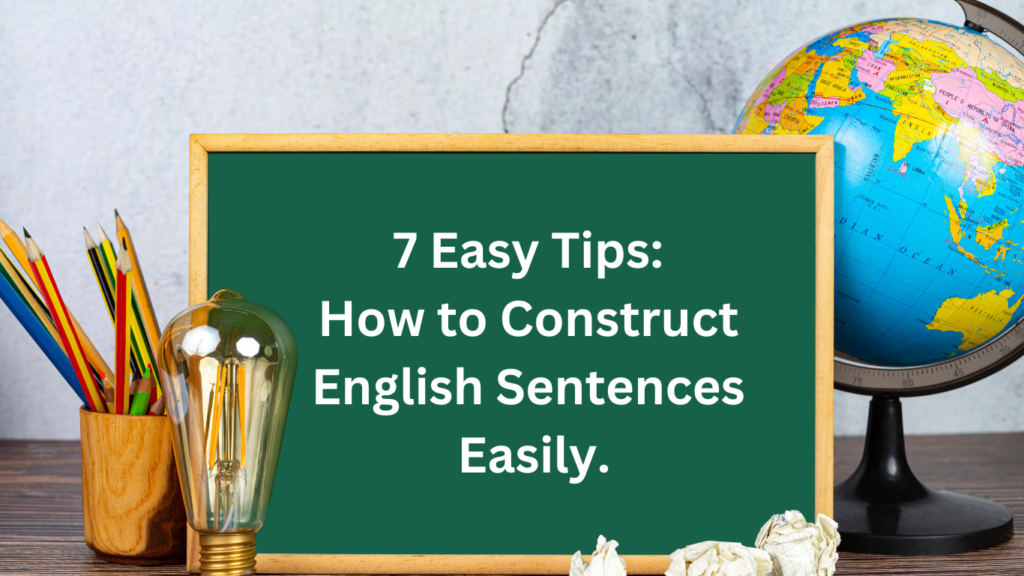
7 Easy Tips: How to Construct English Sentences Easily
Introduction to How to Construct English Sentences Crafting clear and effective English sentences is a fundamental skill that is essential for successful communication, whether in writing or speech. For non-native speakers or those new to the English language, this can seem like a daunting task. However, with a little practice and the right techniques, anyone can learn to construct English sentences with ease. The best place to practice English is the AceFluency App. On this app, you can get daily 20 minutes of FREE calling talk time to connect 1:1 with co-learners. In this blog, we will explore seven easy tips to help you master the art of sentence construction in English. We’ll start by understanding the basic parts of an English sentence, then delve into the proper structure for building simple and complex sentences. Finally, we’ll provide practical, step-by-step guidance on how to implement these tips to construct English sentences with confidence. Basic Parts of Sentences in English Before we dive into the tips, it’s crucial to understand the fundamental components of an English sentence. Every complete sentence in English must contain two essential elements: a subject and a verb. The subject is the person, thing, or idea that the sentence is about, while the verb is the action or state of being that the subject is performing or experiencing. For example, in the sentence “The cat chased the mouse,” the subject is “the cat” and the verb is “chased.” Additionally, many sentences also include other optional elements, such as objects, adjectives, and adverbs, which provide additional information and context. These elements work together to create a complete and meaningful sentence. Understanding the basic parts of a sentence is the foundation for constructing clear and effective English sentences. Also Read : Hardest English Words to Pronounce How to Structure Basic English Sentences? The basic structure of an English sentence follows a simple formula: subject + verb + (optional elements). This formula can be used to construct a wide variety of sentences, from simple, straightforward statements to more complex, compound sentences. Here’s an example of a basic English sentence structure: “The [subject] dog [verb] barked [object] at the cat.” In this sentence, “the dog” is the subject, “barked” is the verb, and “at the cat” is the object. It’s important to note that the subject-verb-object order is the standard sentence structure in English. Adhering to this structure ensures that your sentences are grammatically correct and easy for the reader or listener to understand. Tips To Construct English Sentences Easily Now that you have a solid understanding of the basic parts and structure of English sentences, let’s explore seven easy tips to help you construct them with confidence. Tip 1: Start with simple sentences When you’re first learning to construct English sentences, it’s best to start with simple, straightforward sentences that follow the basic subject-verb-object structure. This will help you get a feel for the basic rhythm and flow of English sentence construction, and build a solid foundation for more complex sentence structures. Here’s an example of a simple English sentence: “The dog barked.” In this sentence, “the dog” is the subject, “barked” is the verb, and there is no object. Simple sentences like this one are easy to understand and can be used as building blocks for more complex constructions. As you become more comfortable with simple sentence structures, you can gradually introduce more elements, such as objects, adjectives, and adverbs. This will allow you to create more detailed and nuanced sentences while still maintaining a clear and coherent structure. Remember, the key is to start small and gradually work your way up to more complex sentence structures. Tip 2: Use common vocabulary When constructing English sentences, it’s important to use vocabulary that you’re already familiar with. This will make the sentence-building process easier and help you avoid common grammatical errors. By sticking to words and phrases that you’ve encountered in your English studies or daily communication, you can focus on the structure and flow of the sentence, rather than struggling with unfamiliar vocabulary. Example: “The girl played with the toy.” In this sentence, all the words used are common and easily recognizable, making it a simple and straightforward construction. As you become more comfortable with English, you can start incorporating more advanced vocabulary into your sentences. However, it’s important to ensure that you understand the meaning and usage of these new words to avoid mistakes. The goal is to construct sentences that are clear, concise, and easy to understand. Using common vocabulary is a key step in achieving this. Tip 3: Pay attention to word order In English, the typical word order is subject-verb-object. It’s crucial to keep this order in mind when constructing your sentences. Deviating from this standard structure can result in sentences that are confusing or grammatically incorrect. Here’s an example of a correctly structured sentence: “The boy rode his bike to school.” In this sentence, “the boy” is the subject, “rode” is the verb, and “his bike to school” is the object. Now, let’s look at an example of an incorrectly structured sentence: “The boy his bike to school rode.” This sentence is grammatically incorrect because the word order is not subject-verb-object. The verb “rode” is placed at the end of the sentence, which is not the standard structure in English. Maintaining the correct word order is essential for constructing clear and effective English sentences. By consistently following the subject-verb-object structure, you’ll ensure that your sentences are easy to understand and grammatically sound. Tip 4: Incorporate modifiers Once you’ve mastered the basic sentence structure, try incorporating modifiers such as adjectives and adverbs to add more detail and nuance to your sentences. Adjectives describe nouns (e.g., “the tall tree”), while adverbs describe verbs (e.g., “he ran quickly”). Here’s an example of a sentence with modifiers: “The tall, graceful ballerina danced beautifully on the stage.” In this sentence, “tall” and “graceful” are adjectives that describe the ballerina, and “beautifully” is an adverb that describes the way she



